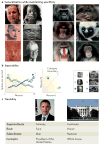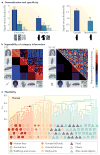The functional architecture of the ventral temporal cortex and its role in categorization
- PMID: 24962370
- PMCID: PMC4143420
- DOI: 10.1038/nrn3747
The functional architecture of the ventral temporal cortex and its role in categorization
Abstract
Visual categorization is thought to occur in the human ventral temporal cortex (VTC), but how this categorization is achieved is still largely unknown. In this Review, we consider the computations and representations that are necessary for categorization and examine how the microanatomical and macroanatomical layout of the VTC might optimize them to achieve rapid and flexible visual categorization. We propose that efficient categorization is achieved by organizing representations in a nested spatial hierarchy in the VTC. This spatial hierarchy serves as a neural infrastructure for the representational hierarchy of visual information in the VTC and thereby enables flexible access to category information at several levels of abstraction.
Conflict of interest statement
The authors declare no competing interests.
Figures





Similar articles
-
Attention reduces spatial uncertainty in human ventral temporal cortex.Curr Biol. 2015 Mar 2;25(5):595-600. doi: 10.1016/j.cub.2014.12.050. Epub 2015 Feb 19. Curr Biol. 2015. PMID: 25702580 Free PMC article.
-
The nature of the animacy organization in human ventral temporal cortex.Elife. 2019 Sep 9;8:e47142. doi: 10.7554/eLife.47142. Elife. 2019. PMID: 31496518 Free PMC article.
-
Ultra-high-resolution fMRI of Human Ventral Temporal Cortex Reveals Differential Representation of Categories and Domains.J Neurosci. 2020 Apr 8;40(15):3008-3024. doi: 10.1523/JNEUROSCI.2106-19.2020. Epub 2020 Feb 24. J Neurosci. 2020. PMID: 32094202 Free PMC article.
-
Optic flow analysis for self-movement perception.Int Rev Neurobiol. 2000;44:199-218. doi: 10.1016/s0074-7742(08)60743-6. Int Rev Neurobiol. 2000. PMID: 10605647 Review. No abstract available.
-
Integrated model of visual processing.Brain Res Brain Res Rev. 2001 Oct;36(2-3):96-107. doi: 10.1016/s0165-0173(01)00085-6. Brain Res Brain Res Rev. 2001. PMID: 11690606 Review.
Cited by
-
A highly selective response to food in human visual cortex revealed by hypothesis-free voxel decomposition.Curr Biol. 2022 Oct 10;32(19):4159-4171.e9. doi: 10.1016/j.cub.2022.08.009. Epub 2022 Aug 25. Curr Biol. 2022. PMID: 36027910 Free PMC article.
-
Generative Models for Active Vision.Front Neurorobot. 2021 Apr 13;15:651432. doi: 10.3389/fnbot.2021.651432. eCollection 2021. Front Neurorobot. 2021. PMID: 33927605 Free PMC article.
-
Neurofunctional Signature of Hyperfamiliarity for Unknown Faces.PLoS One. 2015 Jul 8;10(7):e0129970. doi: 10.1371/journal.pone.0129970. eCollection 2015. PLoS One. 2015. PMID: 26154253 Free PMC article.
-
Identification of a distinct association fiber tract "IPS-FG" to connect the intraparietal sulcus areas and fusiform gyrus by white matter dissection and tractography.Sci Rep. 2020 Sep 23;10(1):15475. doi: 10.1038/s41598-020-72471-z. Sci Rep. 2020. PMID: 32968114 Free PMC article.
-
The Role of Agentive and Physical Forces in the Neural Representation of Motion Events.J Neurosci. 2024 Jan 10;44(2):e1363232023. doi: 10.1523/JNEUROSCI.1363-23.2023. J Neurosci. 2024. PMID: 38050107 Free PMC article.
References
-
- Thorpe S, Fize D, Marlot C. Speed of processing in the human visual system. Nature. 1996;381:520–522. - PubMed
-
- Grill-Spector K, Kanwisher N. Visual recognition: as soon as you know it is there, you know what it is. Psychol Sci. 2005;16:152–160. - PubMed
-
- Ungerleider LG, Mishkin M. In: Analysis of Visual Behaviour. Ingle DJ, Goodale MA, Mansfield RJW, editors. MIT Press; 1982. pp. 549–586.
-
- Tong F, Nakayama K, Vaughan JT, Kanwisher N. Binocular rivalry and visual awareness in human extrastriate cortex. Neuron. 1998;21:753–759. - PubMed
-
- Grill-Spector K, Kushnir T, Hendler T, Malach R. The dynamics of object-selective activation correlate with recognition performance in humans. Nature Neurosci. 2000;3:837–843. - PubMed
Publication types
MeSH terms
Grants and funding
LinkOut - more resources
Full Text Sources
Other Literature Sources

